|
Bristle/Fireworms Identification
FAQs 4
Related FAQs: Polychaete ID 1, Polychaete ID 2, Polychaete ID 3, Polychaete ID 5, Bristleworm ID 6, Bristleworm ID 7, Bristleworm ID 8, FAQs: Worm Diversity
FAQs, FAQs
2, FAQs 3, & Worm IDs
1, Worm IDs
2, Worm IDs 3, Worm IDs 4, Worm
IDs 5, Worm IDs 6, Worm IDs 7, Worm
IDs 8,
Bristleworm ID 9,
Bristleworm ID 10,
Bristleworm ID 11,
&
Worm ID FAQs by Group/Phylum: Flatworm Identification ID, Nemertean, Proboscis, Ribbon Worm ID,
Nematode, Roundworm ID,
Nematomorpha,
Horsehair Worm ID, Acanthocephalans,
Thorny-headed Worm ID, Tubeworm ID, Hirudineans, Leech ID, Sipunculids, Peanut Worm ID, Echiuran Worm ID, & Bristle/Fireworms 1, Bristle/Fireworms 2, Bristle/Fireworms 3, Bristle/Fireworms 4, Worm
Identification, Polychaete Behavior, Polychaete Compatibility, Polychaete System, Polychaete Selection, Polychaete Feeding, Polychaete Disease, Polychaete
Reproduction,
Related Articles: Worms,
Polychaetes, Flatworms/Planaria,
|
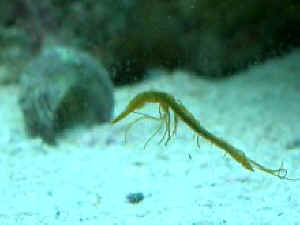
|
Bristleworms... Just Doing Their Job - 10/10/06 Can
anyone identify this nasty looking little worm? <<Appears to be a
species of common bristleworm...a polychaete worm>> I put a
couple of bivalves (Manila clams) into my marine aquarium and two days
later found dozens of these had scoured out the interior of the
clams. They are present in my substrate reef tank.
<<Indeed, and doing what they do best...cleaning up "already
dead" organisms. The Manila clams are found in
temperate to cold waters...they probably died shortly after being
placed in your "tropical" reef tank and the worms, being
beneficial detritivores, "cleaned them up">> Worried
about my pink tipped anemone. <<No need...as long as you keep it
healthy>> Turbo snails have died but I have attributed that to my
hermit crab population. <<Yes...a much bigger threat to the biota
in your tank than the worms...in my opinion>> Sounds like these
would be a nightmare to get rid of. <<I wouldn't even
try...in fact...I feed mine in my refugium purposely to keep the
population up/reproducing/spewing eggs and sperm to the benefit of my
other reef denizens>> I could see benefits of them cleaning and
stirring my crushed coral substrate but if they are more of a problem?
<<Not in my opinion...and populations can usually be controlled
by the amount of available (excess) food in the system>> Do they
natural predators that I could but for control? <<A few...though
these can be/have their own problems>> Help! Your professional
advice please! <<Relax and enjoy... These worms are a
beneficial, even necessary detritivore>> Randy Stewart
<<Regards, Eric Russell>>
| Bristleworms 9/27/06 WWM Crew,
<Mark> First of all I just wanted to let you all know this
site has been an excellent source for me as a new SW Aquarium
hobbyist. But I awoke this morning to find an ominous
looking fellow in the corner of my tank. I suspect he
came out of the LR, but it's been in my tank for over 6 months
now and this is the first time I have seen it. I tried
to ID it and the best I could come up with is some type of bristle
worm (large version). Any idea what type of worm it is? And should
I get rid of it? <Is a bristle worm, and I would
remove. Smaller ones generally pose no problems, but
this guy would go if it were me. Forceps work well in
removing them, and by all means, do not remove with your fingers. I
have removed your personal information for your own privacy, as
these queries are posted, and looked at by thousands of
people. In future queries, your first name is all that
is necessary. James (Salty Dog)> Mark |
|
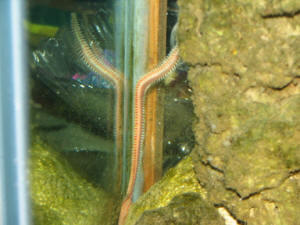
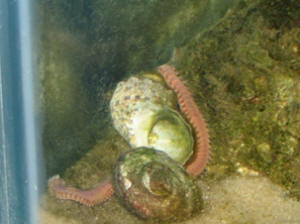
|
| You have new Picture Mail! And Crap
English! - 09/14/06 Hey yous, great site yous got here, I
spend lots of hours just checking things out. Well I'll be short
with this question, what the heck is this? found it in my refugium
this morning on the glass in the skimmer section. tank is only up
and running three months,75 gal, 100 lbs of live rock, 3 inches of
live sand, two damsels so far and apparently this thing, your help
would be appreciated, thank you,,, Chris..P.S sorry for
the pic its from my cell phone. <... bizarre... but looks like a
terrestrial larval insect... of which there are exceedingly few
that are marine (though quite a few that are freshwater). This is
likely a juvenile polychaete worm. BobF> |
|
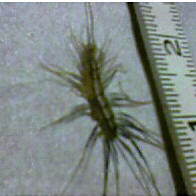
|
Annelid identification 7/15/06 Hey, <Is
for equines s'posedly> I'm hoping that you can identify, or
at least give me some clues as to where I could look to find out what a
certain annelid is in my tank. <... there are dozens of families,
thousands of species> The origin of all the rock and sand is from
the gulf coast of Florida. <Helps narrow down the possibilities>
The animals in question are around 1-2mm thick and of an unknown length
as they live in tubes they construct from the substrate. They have
three large, apparently sensory antennae on their heads, and two (or
maybe more) small, pale appendages which they use to manipulate the
substrate and drag sand to add to their tubes. <Oh,
tube-dwelling...> They are overall a pale brownish orange colour,
which is more brown on the head and first five segments, followed by a
slightly longer section of lighter orange, and then an unknown length
(but longer than the previous sections) of a darker brown colour. They
can retract into their tubes quite rapidly, often while grasping a
sizeable grain of sand. They don't appear to be the standard
bristle worms, as they do not seem to have as many setae, and they have
the antennae. Any idea what these could be? Thanks in advance! -Van
<Good descriptions... and I did at one time sort and identify
errantiates (for USD for a couple of years, for dredge-spoil
analyses...), but I couldn't tell you even to what family this
animal is. Perhaps try the Net... "Polychaetes of Florida"...
or it's off to a large library (college) for a search. Bob
Fenner>
| Bristleworm? Worm ID - 10/21/2005 WW Crew,
<Bryan> I think I have it ID'd but just want to make
sure. I found this little critter making his way out of one of my
rocks. In the picture it is about half its normal size. I think
it's just a bristle worm, would I be right? <Yep, looks like
a Bristleworm to me. Or a piece of one, at least.> Because of
its size could this one harm my soft corals and inverts?
<Highly unlikely. More likely that this animal will be a mostly
harmless detritivore for you.> Thanks, -Bryan <Wishing you
well, -Sabrina> <<I am unable to "snag" the
photo (save as). Is of a polychaete-type worm, fleshy, from pale
tan and pink to brown in color, with lots of bristles. Worm
was shown next to U.S. quarter, probably about 1/4" in
length. Marina>> |
|
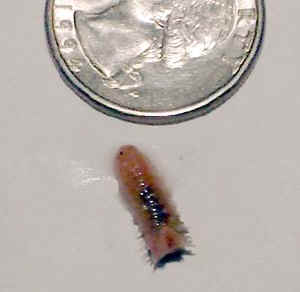 here tis
here tis
|
Feather Dusters ? 8/15/05 Hello Crew <Howdy>
I wish that I could send you a picture of this one. I have
an overstocked 55g FOWLR. I am preparing a
180g to transfer my fish over to. The 55 has been
going for about a year now. I have had 3 feather dusters
in there for about 6 months. I was adding 2 capfuls of live
phytoplankton every other day until the tank developed an
algae bloom that I felt might be feeding off of the
phytoplankton. I realize that my high nitrates, 40 to
50mg/L , and phosphates, 2.75mgL , aren't helping,
<Yikes, I'll say> but I read that the algae
could be feeding off the food that I was adding for the
worms. <Might, not likely a factor though... you've really got
to address your water quality> I added
a 24 " hang-on refugium six weeks ago with live rock,
live sand, and red and green macro algae that a local fish store
sold me. The algae is full of all kinds of tiny critters
that are multiplying like rabbits. My Foxface and
tangs love the algae but I was wondering if these small
copepods or whatever are being eaten by the feather dusters. <Very
likely so> Back to the main question. I went on
vaca <A cow?> for two weeks. Someone fed the
fish, emptied the protein skimmer, and did a 10 %
water change while I was away. When returning, I noticed all
the fish alive and well, but 2 of the three worms are closed
up and there are 4 small, about 1/2 " tall reddish
worms growing on a piece of rock . Their feathers appear to
be less uniform and spaced further apart than the real
feather dusters. The stems are transparent. Are
these nuisance worms or "children" from the
larger worms ? And should I remove them ?
Thanks for your help. <More likely the latter, and
I'd leave them be, transfer them to the new system... now, about
that water quality... Bob Fenner>
| Unknown Critter 7/23/05 Dear WWM Crew, <Ronnie> I
have searched your site and others and have not found anything
exactly like what I have found in my tank. The tank (30 gal. with
about 25 lbs. of live rock and a 10 gal. sump) has been set up for
almost three months, all the water parameters have remained in the
desired range, although pH and calcium are currently
marginal. I have a few soft corals and no fish have been
added yet. The other day I moved a small piece of live
rock and a "worm" that had been under it remained in the
substrate. It has a gray body about an inch and a half
long with thin reddish tentacles at one end. Apparently
overnight it buried itself in the substrate and began building a
mound of sand. <Neat> The long tentacles are
about one to two inches long and it uses these to pull grains of
sand to build the mound. At the center of the mound
about six or seven short spines project upward. This guy
doesn't look friendly. I'm sending a picture.
<A nice one at that> The long tentacles are just visible in
this shot. Do you know what it is? Thanks Ron <Mmm,
not exactly... some sort of polychaete likely... but there are
thousands of species... I would not remove it at this juncture
though... More to come as your system "matures"... Bob
Fenner> |
|
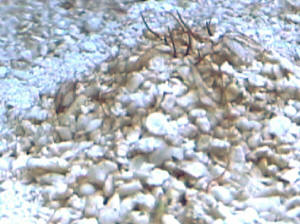
|
| Worms ID? Pictures included Dear Anthony
and crew, <Hey there> Last night I noticed one of the worms
in my tank moving around a Turbo snail that has not acted
"normal" for the last week. We took the enclosed photo
and then got a probe out and started poking around. The worm was
definitely eating the snail. I am a little worried since I have
several other critters in the tank that I don't want the worm
to eat (T. crocea, Nudibranch, another snail, and a cleaner
shrimp). I have seen the worms quickly find the shed casing from
the shrimp and eat it but the worms never seem to try to get
anything that was alive and well. If this is just normal activity
for a non harmful worm then that is fine. If this is a worm that
needs removal I am ready to try that too. I looked in your book but
could not decide what to call this worm. He is very stretched out
in this photo. He appears to have been about seven inches in
length. He was as you can see very stretched. After removal of the
snail shell he snapped back abruptly and disappeared into the rock.
This was about an hour after the halides had turned off and 30
minutes after the VHOs shut down. Joel PS Enjoying both of your
books. Thanks so much for the hard work put into them. <Joel...
from your description and pic I would definitely remove this
worm... too big and predaceous to be trusted. Watch your hands on
the "podia" structures (the furry things on the sides) as
these are likely very sharp, possibly venomous. Bob Fenner> |
|
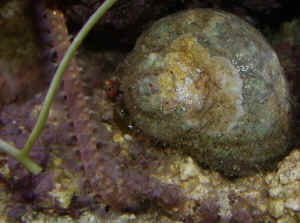
|
| - Worm ID - Greetings, I have acquired a
few new additions to my freshly started Salt tank. These are from
The Keys in Fl. The brownish worm is approximately 3 inches in
length, looks like he's a detritus eater the way he touches
everything with his feelers/tentacles. Am I correct, and is he a
reef safe guy? <You are correct, it is a worm and appears
to be a type of Medusa worm... feeds on small particles both in the
water column and in the sand. Will likely not fare well in a new
tank - would need a mature tank [1 year old or more] to thrive.
Cheers, J -- > |
|
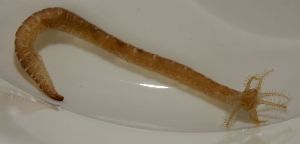
|
| Yellow worms ID - medusa/spaghetti
4/25/04 Hello, <cheers> I have a 125
Gal reef which I have had for about 5 years. Just over the last few
months I have noticed these yellow worms like creatures. They
remind me of almost anemone like. Most of the time they are buried
under the sand or in my live rock with very thin tentacles sticking
out. Taking pictures of them like that didn't come out very
well so I waited until I could get a few with them stuck to the
glass. If you could tell me what they are and if I need to get rid
of them and how I would be very grateful. I tock these same
pictures to the reef shop where I have bought all my live stock and
he had no idea. I looked on the internet but not knowing what they
were called didn't help much. Any info would be great. Thank
You Chris Twining <the pictures are clear enough of this
unique animal my friend. Thank you. It is a harmless/helpful medusa
worm (a true worm, not to be confused with the sea cucumber
relative Synaptids of the same common name). Look at pages 170/171
of our new Reef Invertebrates book or online with the genera
"Timarete" or "Loimia" for more information.
Kindly, Anthony Calfo> |
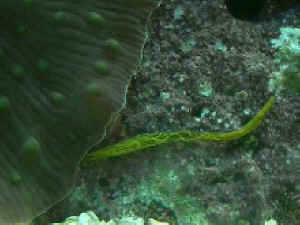 |
 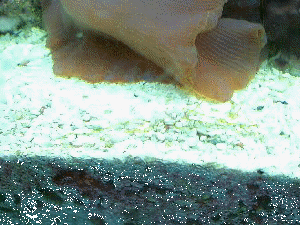 |
|
|

